Day 1 of a three day long weekend of tours, which will see us visit various parts of Norfolk. Today was the turn of the North Norfolk coast. It was a cold and cloudy day, with a couple of wintry showers particularly in the afternoon, although we managed to dodge the worst of them.
Our first destination was Holkham. As we parked on Lady Anne’s Drive, we could see lots of birds out on the wet grazing meadows either side of the road. A large flock of Wigeon was feeding on the grass near the fence, the birds giving their distinctive ‘wheeoo’ whistle. There were also a few Teal and Shoveler out in the field with them, as well as lots of Common Redshank feeding around the pools. On the other side of the road, a single Pink-footed Goose was all alone out in the middle, presumably a sick or injured bird.
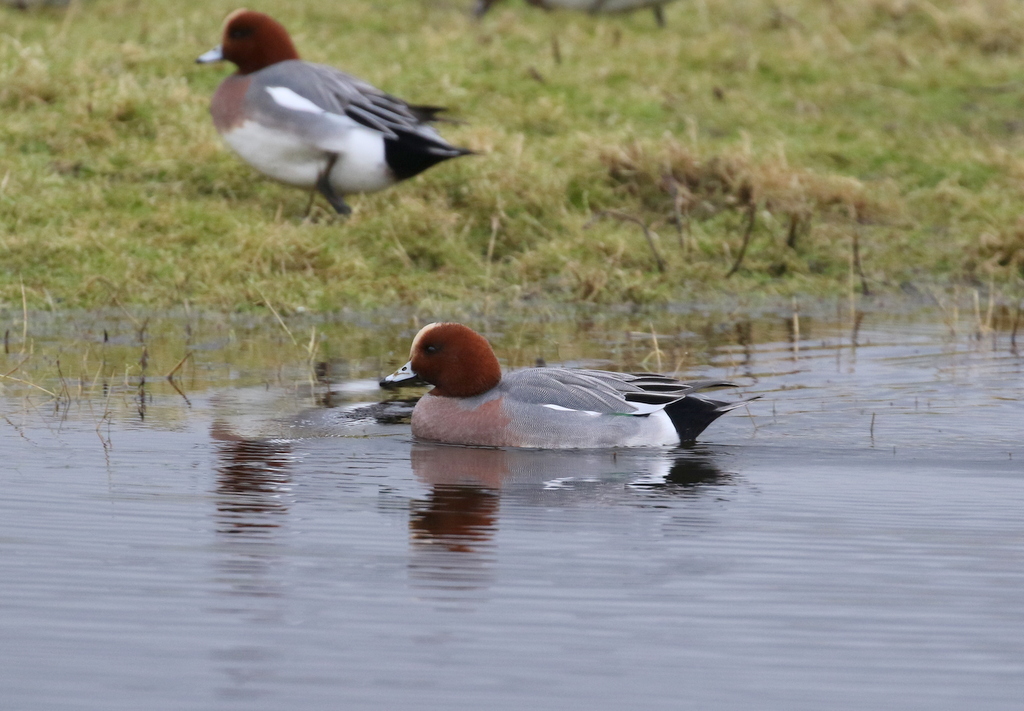
We were heading out towards the beach, but a shower blew in at that point and we sought shelter under a large holm oak by the start of the boardwalk for a couple of minutes while it passed over, watching the Brent Geese flying in to feed on the grazing meadows. A flock of Golden Plover whirled round and dropped down again out of view.
The rain stopped quickly and we made our way through the pines. A Sparrowhawk flew over the Gap ahead of us, before disappearing over the tops of the trees. We heard a Goldcrest singing and managed to locate it, feeding busily in a holm oak. There were lots of Shelduck out on the saltmarsh, but otherwise it seemed fairly quiet out here today. We flushed a small group of Goldfinch from the edge of the dunes as we made our way east.
There was no sign of the Shorelarks in their usual favoured spot out on the saltmarsh, but it was quite wet out here after heavy rain overnight. So we continued on a little further east and, scanning the ground ahead of us as we went, we quickly located them out on the drier sand. We had a quick look through the scope in case they flew, then made our way over a little closer.
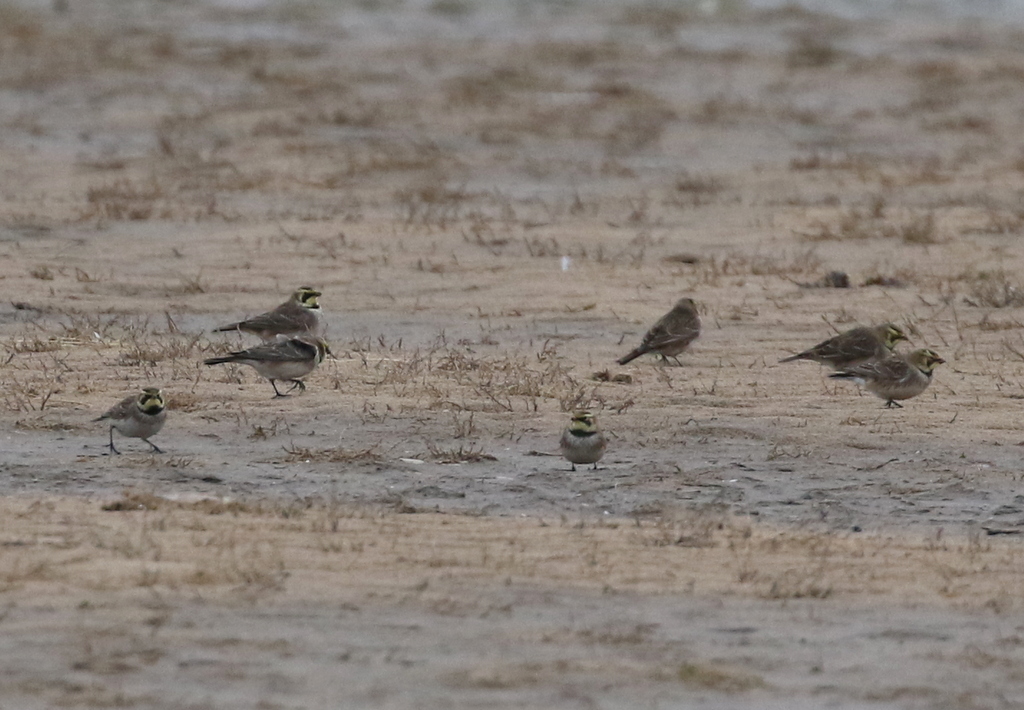
We watched the Shorelarks for a while from a discrete distance. They were feeding busily, running round, picking at the dead stems of vegetation, occasionally flying up and landing again. Through the scope, we got a good look at their yellow faces and black masks.
As we made our way back, we stopped briefly to scan the sea. It was fairly choppy and looked rather quiet – just a few Cormorants out on the water and a couple of distant Red-throated Divers flying past.
There was more action back at Lady Anne’s Drive. As we came through the pines, we spotted a Red Kite flapping lazily across the grazing marshes. Back at the car, we could see a large flock of Brent Geese now out on the grass and a quick scan through revealed a slightly darker bird with a more obvious pale flank patch, one of the usual Black Brant hybrids which can often be seen with the Dark-bellied Brents here.
Driving back towards the main road, we noticed a few thrushes out on the short grass in one of the fields. A quick stop and check confirmed they were mainly Fieldfares, but with a single Song Thrush and a pair of Mistle Thrushes alongside. A Great Spotted Woodpecker flew across and disappeared into the bushes.
A little further west, another stop to scan the grazing marshes quickly revealed a few Russian White-fronted Geese feeding down in the wetter grass. The first pair were rather distant, but then a family of four appeared from behind the trees down at the front. We could see the white surround to the base of the bill and the black belly bars on the adults. There were lots of Egyptian Geese and Greylags here too, plus a few Canada Geese and a single Barnacle Goose which had presumably hopped over the wall from the feral group in the Park.
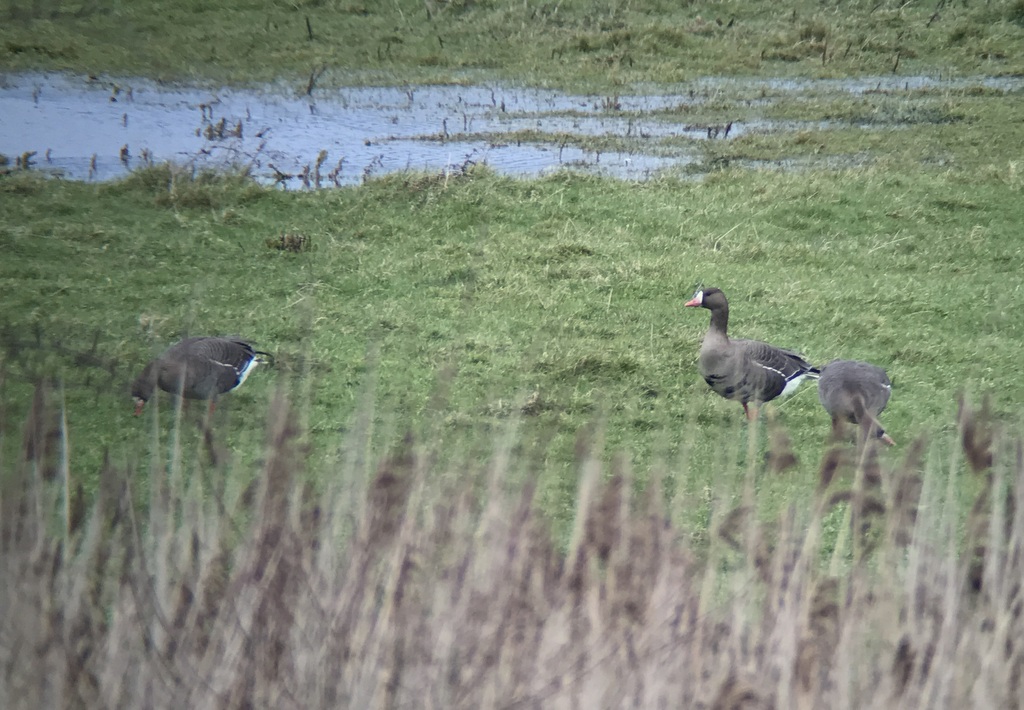
There were a few waders out on the wet grass too. A large flock of Black-tailed Godwits was busy feeding, probing for worms with their long bills. Careful scanning also revealed a couple of Ruff, though they were very flighty and kept disappearing behind the trees. A female Marsh Harrier appeared in the top of a bush in front of us. A Green Woodpecker flew in across the marshes and disappeared over the road into the park.
Then one of the group spotted a Great White Egret, the other bird we were hoping to catch up with here. It was right over the back, against the reeds below the pines, but it was immediately obvious that it was big even at that distance and through the scope we could see its long, dagger-shaped yellow bill.
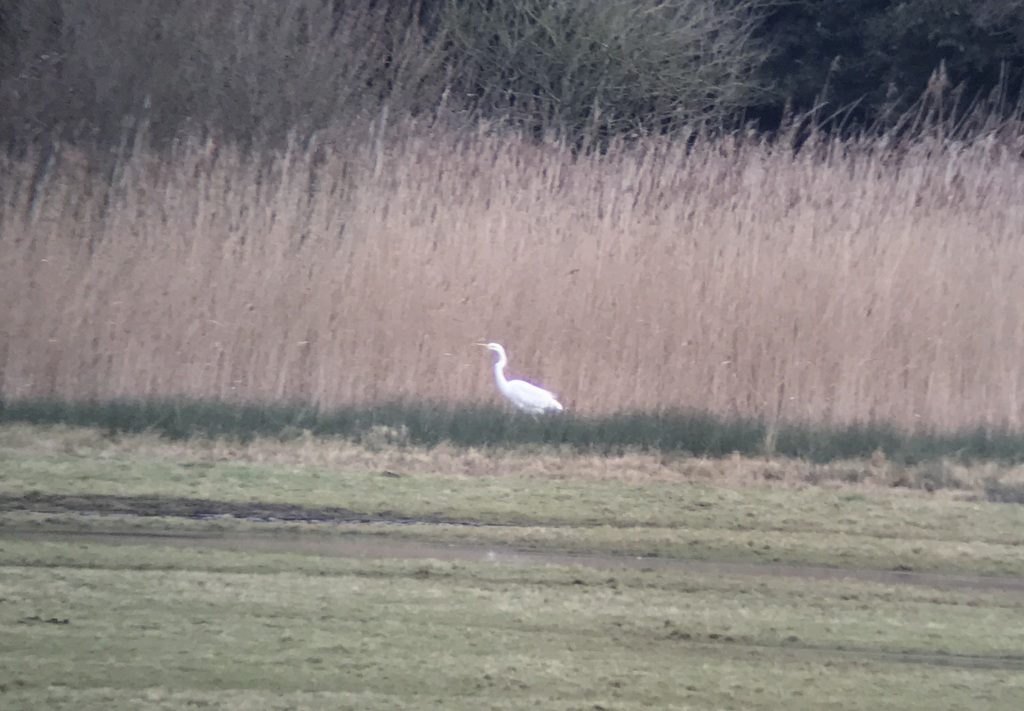
After a very productive short stop here, we continued on our way west. One of the group had asked about Bean Geese earlier. They have been very thin on the ground this winter, but fortuitously we received a message at this point that one or two had been reported along the coast at Ringstead again this morning, having first been mentioned yesterday. We made our way straight over.
It wasn’t immediately clear where the geese were (‘in field viewed from beet pile’ perhaps not being the most helpful of directions!!), so we had a drive round the area. A quick stop by a cover strip sown along the edge of a field revealed a hedge full of birds. On one side, we could see loads of Reed Buntings and Yellowhammers, but the other side revealed our target here – several Tree Sparrows. It is a sad sign of the times that we have to go some way these days to find this once very common species.
While we were here, we worked out where the geese were most likely to be found and when we got round there we found a couple of cars pulled up on the verge. A large flock of a thousand or two Pink-footed Geese were feeding out on a recently harvested sugar beet field. One of the Tundra Bean Geese had been seen earlier, close to the front of the flock, but had disappeared. At least that narrowed the search area a little, and we quickly managed to locate it, fast asleep, sitting down, hiding its best features – the orange legs and bill band!

Through the scope we all had a good look at it. Even though we couldn’t see its legs or bill, the Tundra Bean Goose was subtly different from the surrounding Pinkfeet, with noticeably darker feathers on the back and wings with more contrasting pale edges. Thankfully, after a while it woke up and started to walk round, feeding on the bits of beet left behind in the field. At that point, its day-glo orange legs were particularly striking!
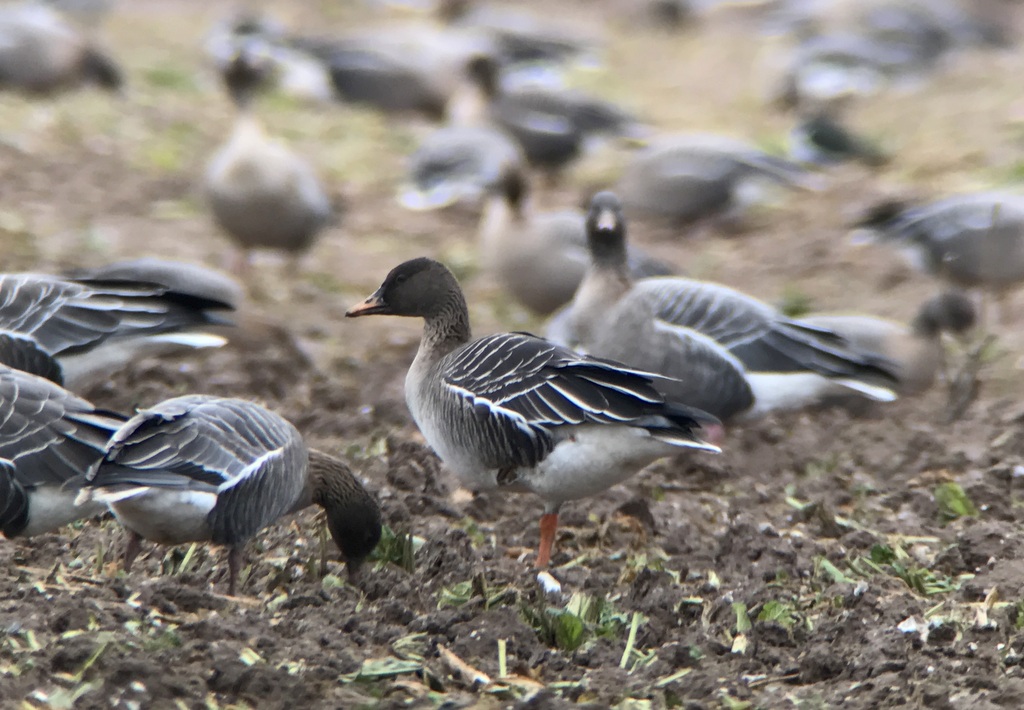
After enjoying great views of the Tundra Bean Goose, we dropped back down to the coast at Thornham and headed out to the harbour. As we drove down past the old coal barn, we could see four people with binoculars staring down at the saltmarsh by the road and as we pulled alongside we could see Twite flitting around in the vegetation. We pulled in just past them, by the barn, but at that moment they took off and flew away up the harbour.
Parking down at the end, we had a look in the Twite‘s other favourite spots. We walked up to the corner of the seawall and scanned the saltmarsh, but we couldn’t see them anywhere. There were lots of waders in the harbour – several Curlew and Grey Plover, Black-tailed and Bar-tailed Godwits, and Redshank. A couple of Little Grebes were diving in the channel and further out we could see a pair of Red-breasted Mergansers.
Then a little flock of about thirty small finches flew in with bouncing flight, straight past us. The Twite had returned. They circled round over the car park, where they usually like to drink in the puddles, but were possibly put off by the number of cars and people. Instead, they flew back towards us and landed down on the seawall just a few metres away to drink on the puddles there. We had a great view of them.

The Twite didn’t stay long at the puddles, but quickly took off again, flying round a couple of times before landing a short distance out on the edge of the saltmarsh. Here, we had a good look at them in the scope, before they were off again, this time heading out over the harbour, out of view.
It was time for lunch now, so we made our way round to Titchwell. While we ate, we scanned the feeders by the Visitor Centre. A few Greenfinches arrived to join the numerous Chaffinches and a couple of Long-tailed Tits appeared on the peanuts. Then a couple of Bramblings appeared too, a brighter orange male and a slightly duller female.

After lunch, it started to spit with rain. We had a quick look round via Meadow Trail for the Woodcock, but it was keeping well hidden today. Three Bullfinch flew over our heads calling. We set out onto the reserve. It was cold and windy out of the trees, so we put our heads down and walked quickly out to seek shelter in Parrinder Hide. A Marsh Harrier was circling over the reedbed on our way past.
The staff have been cutting the reeds around the edge of the freshmarsh this week, and it has been very disturbed. Coupled with the still very high water level, this means there are not many birds on here at the moment. Still, recently cut vegetation had attracted a Common Snipe, which was feeding along the edge one side of Parrinder Hide, and a Water Pipit which was picking its way along the edge the other side.
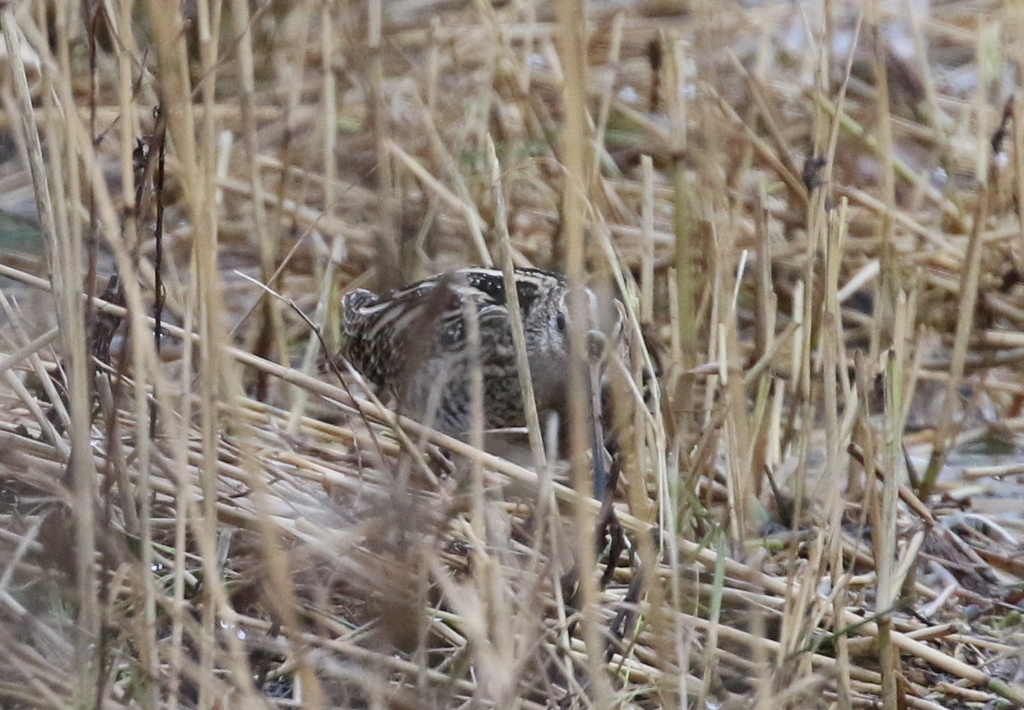
We were glad of the shelter, as a heavy sleet shower then blew in off the sea. We waited for it to pass through in the north side of Parrinder Hide, overlooking the Volunteer Marsh. A particularly forlorn looking Grey Plover was huddled on the edge of one of the vegetated islands, trying to get out of the weather, as were a couple of Avocets. We managed to find a single Knot and a couple of Dunlin, but most of the waders seemed to be hiding.

Once the sleet stopped, more waders arrived. A Ringed Plover appeared from nowhere in front of the hide and several small flocks of Knot and Dunlin flew in and landed on the mud. We decided to brave the cold wind and make a bid for the beach.
There were more waders along the edges of the muddy tidal channel. We had a good close look at a couple of Black-tailed Godwits just below the main path. There were also more Curlew, Grey Plover and Dunlin. Scanning carefully where the channel heads back away from the path, we managed to pick out a single Spotted Redshank on the edge of the water towards the back.
There was not much out on the Tidal Pools now, but it was very windy and exposed out here. Apart from several Little Grebes diving in the water just below the path, there was a large roost of Oystercatcher on the saltmarsh at the back. A pair of Gadwall were lurking in the vegetation nearby.
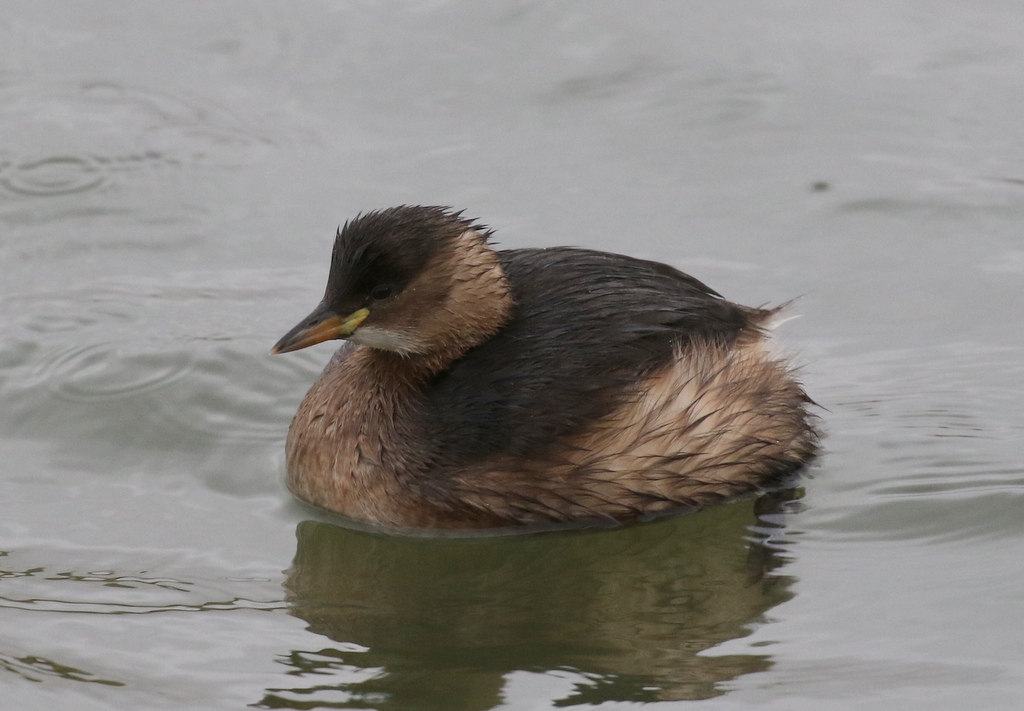
We did make it out onto the beach today and found a bit of shelter in the edge of the dunes. More Bar-tailed Godwits were scattered along the shoreline and we got a single Sanderling in the scope. Another flock of Sanderling flew past, led by a lone Turnstone. The sea was very choppy and it was hard to find anything out on the water. We did get a Goldeneye in the scope, but it proved very difficult to see. The other ducks were even further out. We decided to head back.
As we walked back along the main path, the Marsh Harriers were already gathering to roost. We counted at least 12 in the air together over the back of the main reedbed. By the time we got back to the car, the light was already starting to fade, so we headed for home.
















